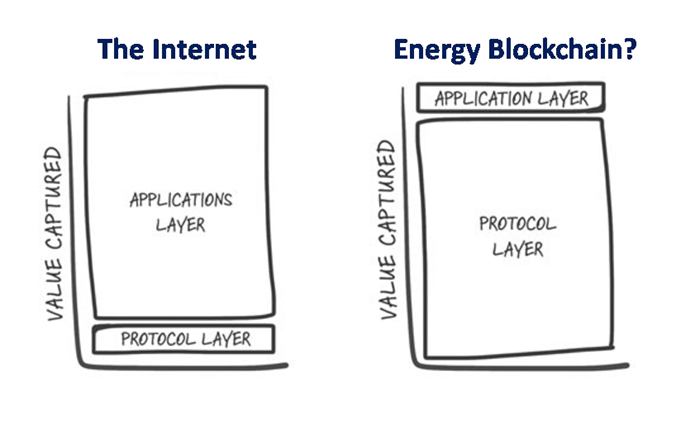- Blockchain
- Digital Transformation
- Digital Currencies
- Digital Age
Energy Blockchain Won't Turn Value Capture Upside Down

Boardrooms around the world are familiarizing themselves with blockchain technology and the ways in which it will create value in their industries. As blockchain matures, a key question is how and where that value will be captured—will it be captured by protocols or by applications? Put another way, will anyone own “the energy blockchain?”
I argue that vendors and developers that stake their futures on owning blockchain protocols rather than applications are making a critical mistake.
Thin Protocols and Fat Protocols
Enter the thin protocol (or fat application) hypothesis, which describes value capture in the age of the internet. No one owns the internet—its protocols are open source, so they capture virtually no value. Internet applications, however, are proprietary, and exceedingly valuable—think of Amazon, Netflix, AirBnB, and the many other companies that recognized this early on.
Internet versus Energy Blockchain Applications

(Source: Adapted and modified from Medium)
There are many who argue that blockchain technology turns this model on its head, and that the future market will look like the righthand sketch in the figure above. This argument could reasonably be made about Bitcoin, where the only value associated with the network is represented by its digital currency, and the digital currency is inseparable from the network protocols.
Energy Blockchain Will Be Another Thin Protocol
But in the energy industry, the fat protocol model is fundamentally wrong. Energy is a service-driven industry. Consumers of electricity want lights to turn on, appliances to run, and cars to charge. End users engage with products and services—they don’t care about how those services are delivered.
Companies that put resources into developing protocols will need to attract developers providing the energy services that will attract customers. To do so, their protocols would have to offer substantial technical or financial benefits to those developers relative to competing technologies on the market. This is something of a chicken and egg problem, since a critical mass of customers can also convince developers that paying a fee to the platform provider is worthwhile. This is the case with Apple’s mobile app store.
Most importantly, a profusion of blockchain protocols are being developed and deployed in the energy sector, and about half are open source. Service providers that build applications on open source protocols won’t have to pass on licensing fees to their end users, which will reduce the cost of delivering services and lowers barriers for customer acquisition.
What Comes Next?
Energy blockchain vendors, and service providers looking to enter the space, must think critically about strategies that will and will not be competitive as blockchain technology matures.
Betting on protocols boils down to betting that one company, or a handful of companies, will own whatever form of blockchain the energy industry embraces in the future. This is a low percentage bet. Even if a company manages to develop a blockchain architecture that is technologically superior to all alternatives, the better technology doesn’t always win. Remember Betamax?